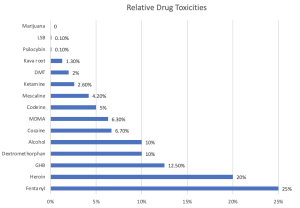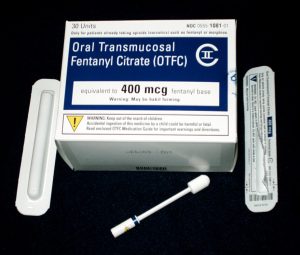19 The Rise of Fentanyl
Dylan DePersia
Introduction
First developed in the 1960s as a numbing agent and pain reliever, fentanyl is a powerful opioid contributing significantly to the opioid epidemic. The recent rise in prevalence of fentanyl is compounded by the dramatic impact that the drug has had on the increasing number of overdoses in the U.S..
Background
Fentanyl was first created with the goal of developing both a powerful and fast-acting pain reliever to be used for cancer-induced pain and as an analgesic after surgical procedures. However, it was not long before the illicit drug market began adding fentanyl to commonly used street drugs. Problems began to arise as individuals who believed they were using pure heroin were actually using a much stronger alternative, laced with fentanyl.
The result has been a dramatic uptick in overdose deaths across the country, rising to nearly 600,000 deaths in the U.S. between 1979 and 2016. In New York City alone, from 2015 to 2017, fentanyl-related deaths increased by a staggering 55% (Han et al., 2019).

Mechanism and Effects
Fentanyl is a semi-synthetic opioid created in laboratories, meaning it is similar but not directly from the poppy plant, although chemicals from the natural plant are used when making fentanyl. Fentanyl and its analogs affect many systems in the body ranging from the central nervous system to the pulmonary system. The drug attaches to fat molecules and plasma proteins inside the body, where it is then carried to the brain and primarily acts on receptors that play a role in how fentanyl can slow down breathing, which can lead to an overdose.
Many side effects on the body can last anywhere from two to 16 hours and range from migraines and dizziness to hallucinations (Han et al., 2019). Digestive symptoms can include nausea and vomiting, while the most notable effects of fentanyl are respiratory depression and bradycardia. This means that it can slow down a person’s breathing and heart rate to an extent that can kill them. Sometimes the heart can stop, or the user’s breathing decreases enough that the brain stops receiving oxygen. To highlight its danger, fentanyl can lead to lethal respiratory depression in just two minutes, whereas in a drug like heroin, an overdose-related death can take up to 20 minutes (Kuczynska et al., 2018). Some people choose to use fentanyl because of its strong relaxation and euphoria effects. The added drowsiness and overwhelming mind-altering effects often mask the sense of imminent danger and leave individuals at a higher risk for overdose.
From the Laboratory to the Street
The primary ways that fentanyl is known to hit the street drug market are from illicit production and from tampering with legal prescriptions (Kuczynska et al., 2018). Illicit production consists of making fentanyl illegally from underground sources, but fentanyl in the United States (US) has been found to be mostly sourced from other foreign countries, primarily from Asian laboratories. One report stated that in 2016 alone, 668 kg of fentanyl powder was seized in the US from China (Kuczynska et al., 2018). Although new Chinese drug classification and stricter exportation surveillance have been implemented to try to slow the shipments of fentanyl, manufacturers have found other routes into the US, such as through routes established by the Mexican drug cartels (Felbab-Brown, 2022).

The second method in which the illicit drug trade acquires fentanyl is by diverting legal, prescription fentanyl products. The most common forms are transdermal patches, lozenges, or even lollipops, usually prescribed for pain management and shown in the included image. Drug users can find a way to get their own prescription, but it is also routine for them to be stolen from family members, unsuspecting elderly patients, and garbage cans outside of hospitals and nursing homes (Kuczynska et al., 2018). Although the patches are believed to be completely used when thrown away, enough of the drug can sometimes linger for a few days. A lethal dose can still be contained in a thrown-away patch, but abusers often stack multiple patches at one time, increasing the likelihood of an adverse reaction or potential overdose. Unused patches can deliver high doses for as long as three days (American Addiction Centers, 2022). Sometimes individuals even eat or chew on the fentanyl patches, insert them into their rectums, or smoke them in foil or a pipe for quicker absorption into the bloodstream (Kuczynska et al., 2018).
Treatment and Prevention
The best way to reduce the risk of consuming fentanyl is through education and awareness. Some myths about fentanyl have been proven false, including that someone can overdose from simply touching fentanyl and that fentanyl is resistant to naloxone. In reality, the drug must be introduced to the bloodstream to have an effect, and it will respond to naloxone in the event of an overdose (National Harm Reduction Coalition, 2021). With such a dangerous drug, there is often no information on how to use it safely. However, once a person has decided to use fentanyl, there are precautions that they can take to try to minimize risk. Starting with a small dose and using it slowly can be important, along with snorting or smoking instead of injecting. Hydrating, eating, and resting are also important in the excretion of fentanyl. Most important to note is the fact that fentanyl test strips are available and can correctly indicate whether the opioid is present in any form of other drugs (National Harm Reduction Coalition, 2021).
Conclusion
Fentanyl’s dangerous traits, including its strength, are the reason that it has contributed to the worsening opioid epidemic. It is much stronger than other available opioids and negatively affects many systems in the body. Whether made from underground resources or pulled from prescription patches, there are ways to reduce the risk of being harmed by fentanyl. Staying educated, using fentanyl testing strips, and taking any possible precautions will reduce the negative outcomes of this drug.
Review Questions
1. Fentanyl is classified as what type of drug?
a. Opioid
b. Stimulant
c. Hallucinogen
d. Depressant
2. True or false: fentanyl was first created with the goal of developing both a powerful and fast-acting pain reliever to be used for cancer-induced pain.
a. True
b. False
3. Which of the following is NOT a common way to consume fentanyl?
a. Transdermal patches
b. Lollipops
c. Lozenges
d. Chewing gum
References
Felbab-Brown, V. (2022, November 7). China and synthetic drugs control: Fentanyl, methamphetamines, and precursors. The Brookings Institution. https://www.brookings.edu/research/china-and-synthetic-drugs-control-fentanyl-methamphetamines-and-precursors/
National Center for Drug Abuse Statistics. (2022, May 3). Fentanyl abuse statistics. https://drugabusestatistics.org/fentanyl-abuse-statistics/
Han, Y., Yan, W., Zheng, Y., Khan, M. Z., Yuan, K., & Lu, L. (2019). The rising crisis of illicit fentanyl use, overdose, and potential therapeutic strategies. Translational Psychiatry, 9(1), 282. https://doi.org/10.1038/s41398-019-0625-0.
Kuczyńska, K., Grzonkowski, P., Kacprzak, Ł., & Zawilska, J. B. (2018). Abuse of fentanyl: An emerging problem to face. Forensic Science International, 289, 207–214. https://doi.org/10.1016/j.forsciint.2018.05.042.
National Harm Reduction Coalition. (2021, May 24). Fentanyl resources. https://harmreduction.org/issues/fentanyl/
American Addiction Centers. (2022, September 15). The dangers of abusing fentanyl patches. https://americanaddictioncenters.org/fentanyl-treatment/dangers-of-abuse
proportion of a population with a disease or condition
a drug that is used to reduce pain
not permitted, unlawful
produced by chemical alteration of a natural starting material
a chemical compound that is structurally similar to another but differs slightly in composition (as in the replacement of one atom by an atom of a different element or in the presence of a particular functional group)
relatively slow heart action
a feeling or state of intense excitement and happiness
relating to, being, or supplying a medication in a form for absorption through the skin into the bloodstream
a synthetic potent antagonist of narcotic drugs

